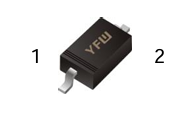Date:2025-06-13 Categories:Product knowledge Hits:468 From:Guangdong Youfeng Microelectronics Co., Ltd
1. Introduction
Switching diodes are a type of semiconductor device widely used in electronic circuits for their ability to rapidly switch between conducting and non - conducting states. They play a crucial role in various applications, such as digital circuits, power supplies, and signal processing systems. The operation of switching diodes is based on the principles of semiconductor physics, and their performance characteristics are highly dependent on their internal structure and material properties.
2. Structure and Material
Switching diodes are typically made of semiconductor materials like silicon (Si) or germanium (Ge). Silicon is more commonly used due to its higher breakdown voltage, lower reverse - leakage current, and better thermal stability compared to germanium. The basic structure of a
Switching diodes consists of a p - n junction. The p - type semiconductor has an excess of holes (positive charge carriers), while the n - type semiconductor has an excess of electrons (negative charge carriers). At the p - n junction, a depletion region is formed, which acts as a barrier to the flow of current under normal conditions.
3. Working Principle
3.1 Forward - Biased State
When a positive voltage (forward bias) is applied across the
Switching diodes, with the anode connected to the positive terminal and the cathode to the negative terminal of the power source, the electric field in the depletion region is reduced. This allows the majority carriers (electrons in the n - region and holes in the p - region) to move across the p - n junction. As a result, a significant amount of current can flow through the diode with a relatively small voltage drop (around 0.7 V for silicon diodes). In this state, the diode is said to be “on” and acts like a closed switch, facilitating the passage of current in the circuit.
3.2 Reverse - Biased State
When a negative voltage (reverse bias) is applied, the electric field in the depletion region is increased. This widens the depletion region and effectively blocks the flow of majority carriers. Only a very small reverse - leakage current, typically in the microampere or even nanoampere range for silicon
Switching diodes, can flow through the diode. In this state, the diode is “off” and acts like an open switch, preventing current from flowing in the reverse direction.
3.3 Switching Process
The key advantage of
Switching diodes lies in their ability to switch quickly between the forward - biased (on) and reverse - biased (off) states. When the diode is switched from the forward - biased to the reverse - biased state, there is a short period called the reverse - recovery time (trr). During this time, the diode does not immediately turn off due to the presence of stored charge carriers in the depletion region. The reverse - recovery time is an important parameter as it limits the maximum switching frequency of the diode. A shorter
allows for higher - speed switching operations, making the diode suitable for high - frequency applications.

